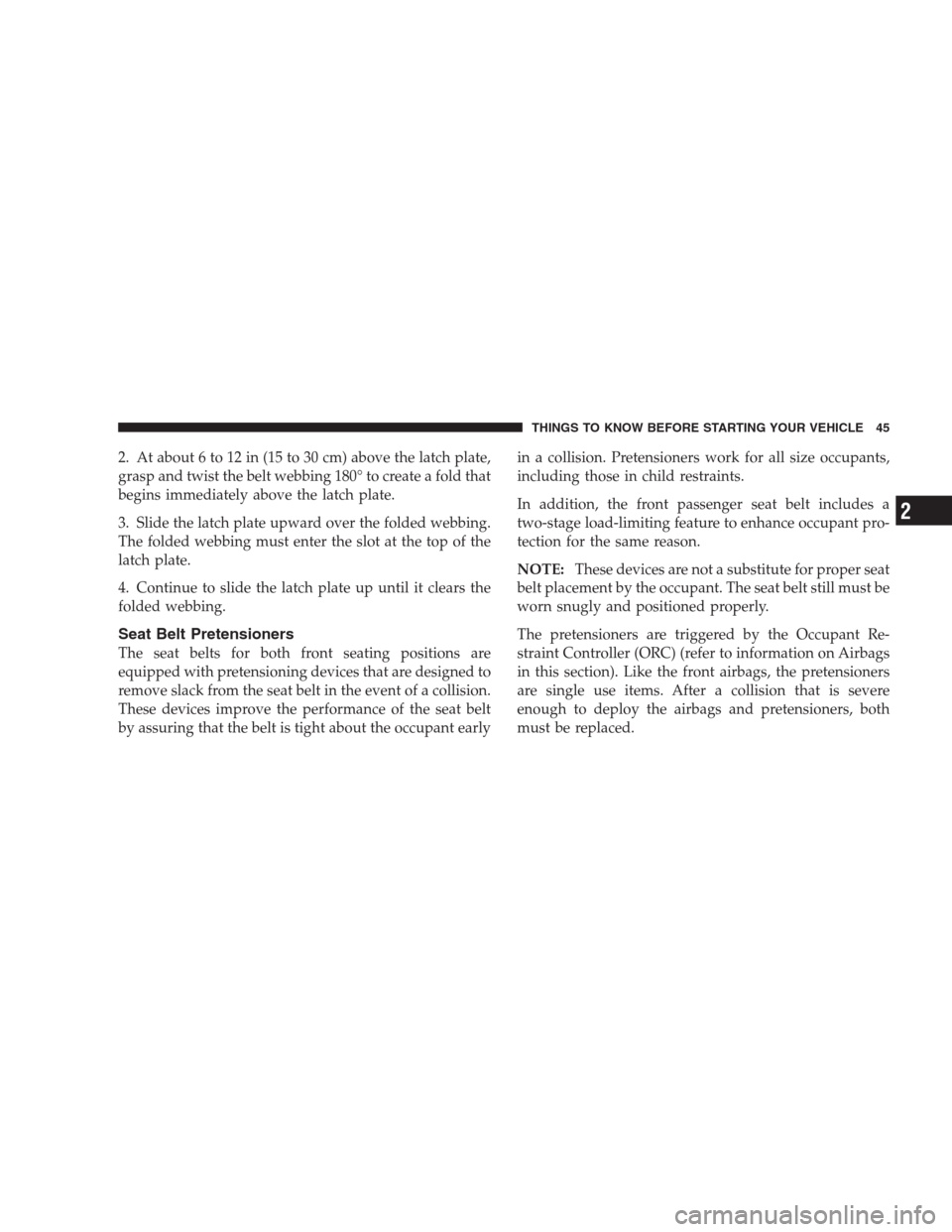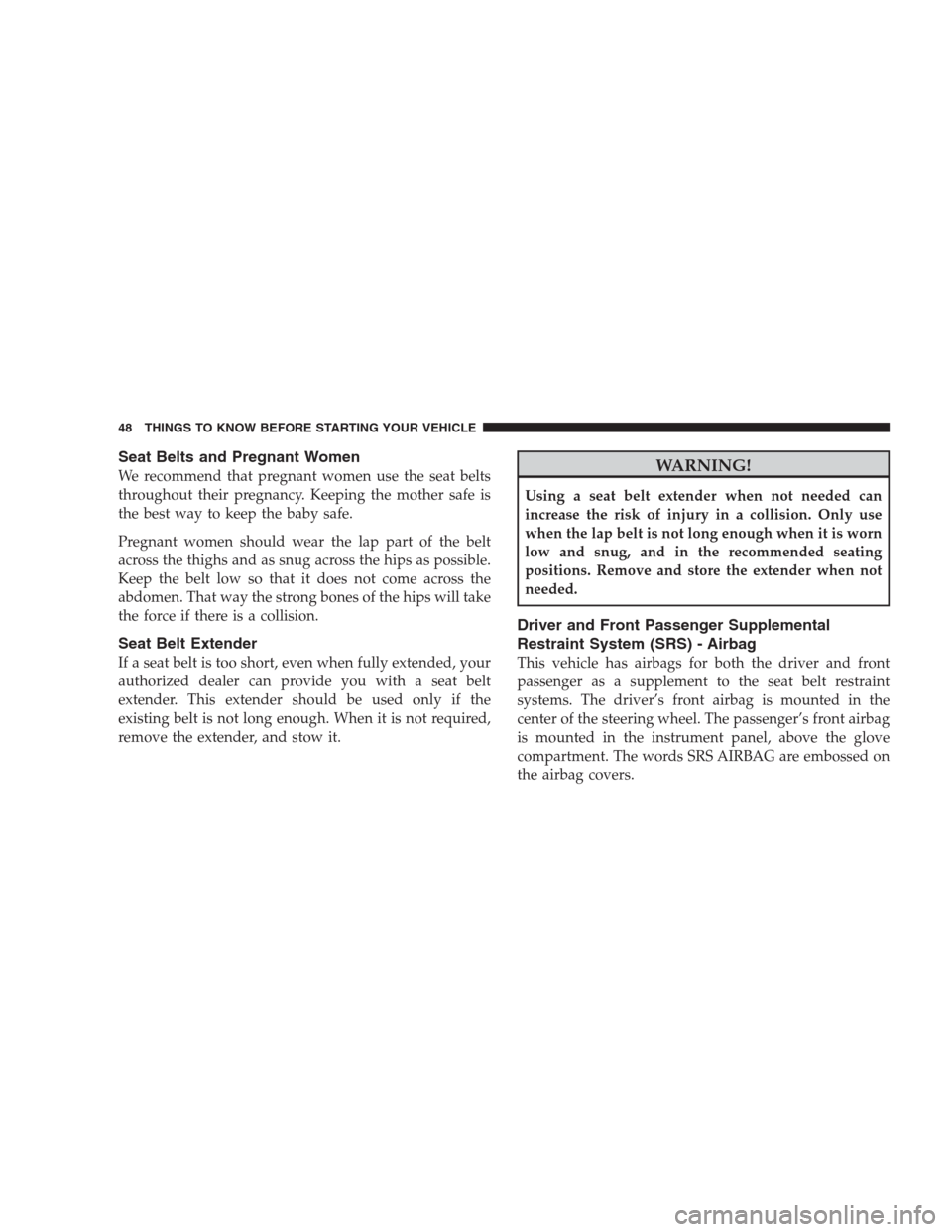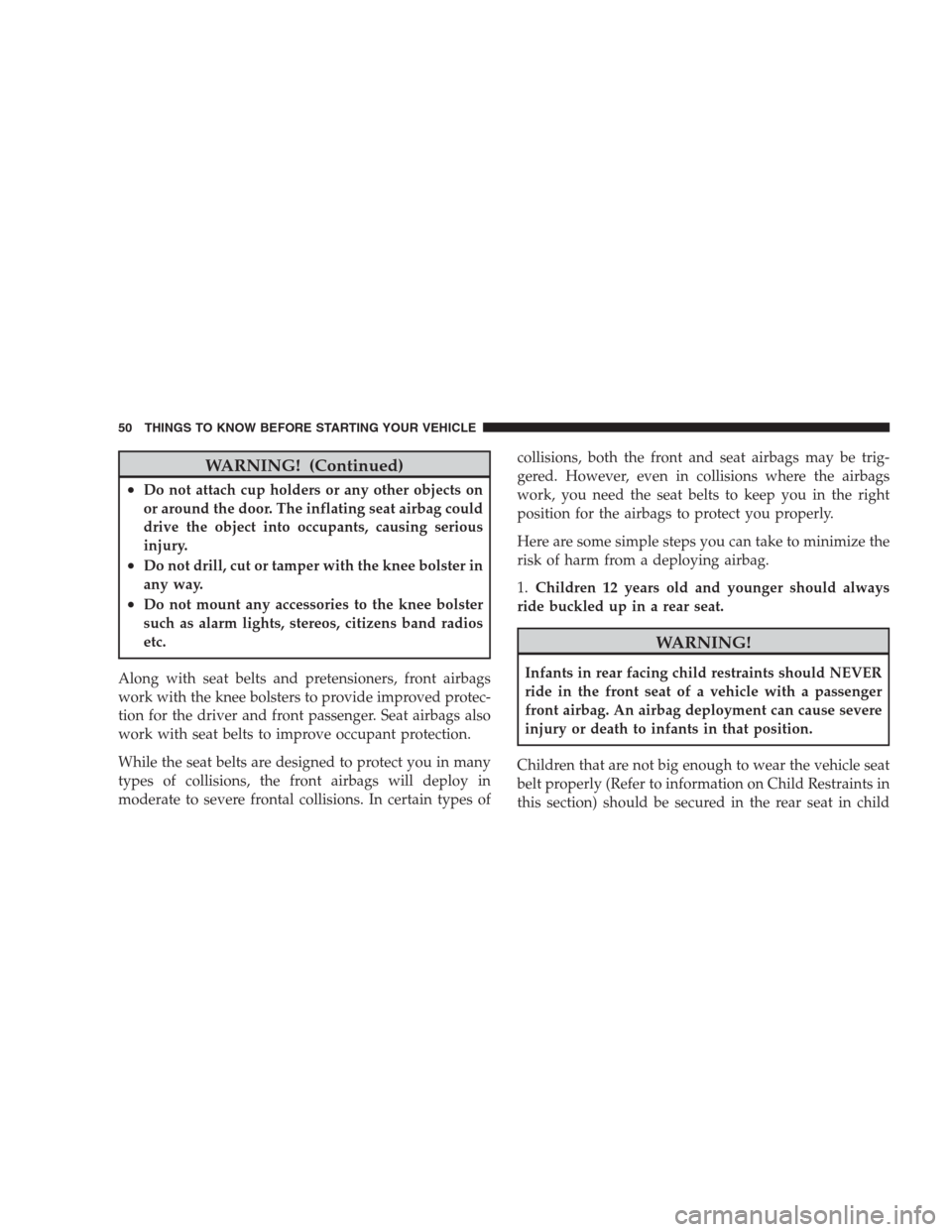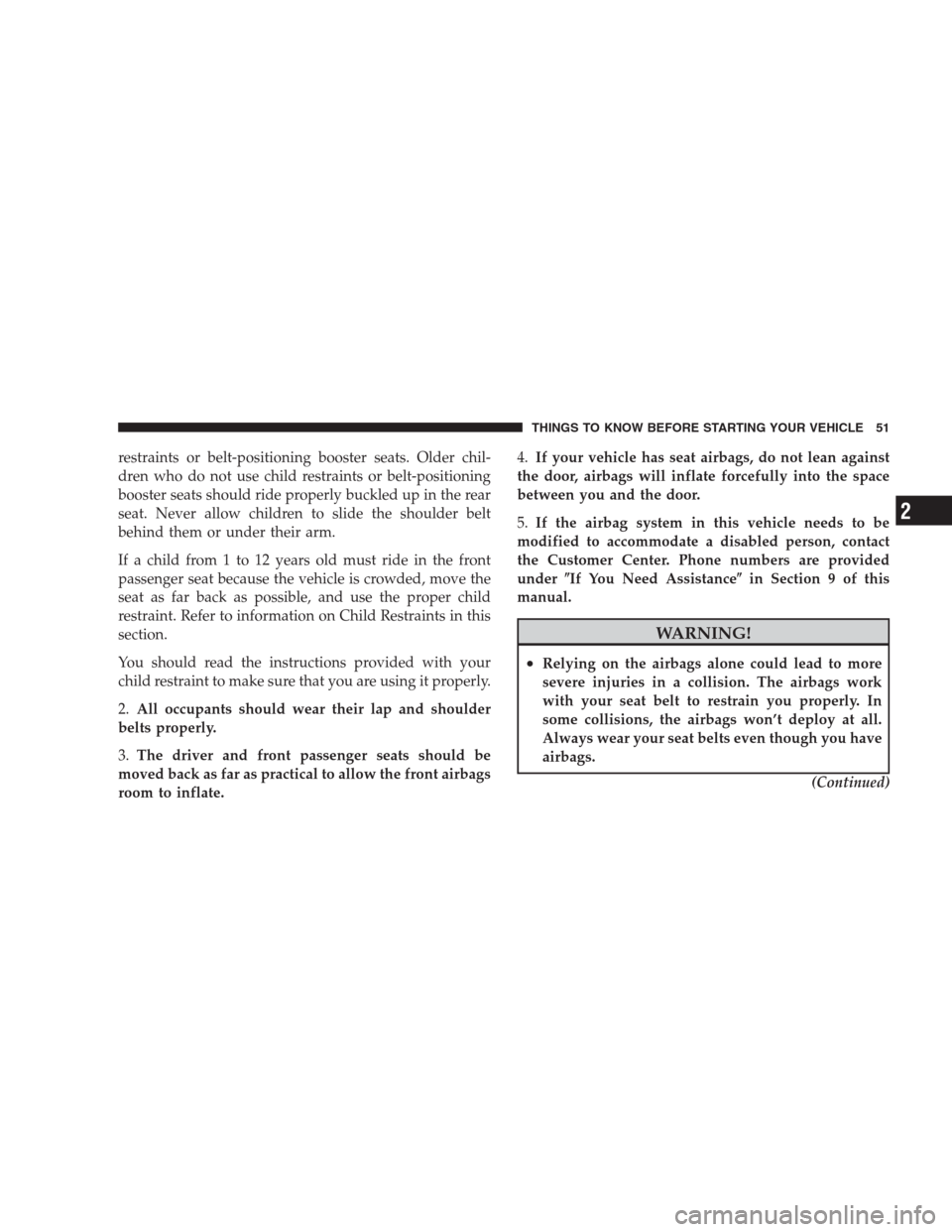Page 13 of 475
▫Driver And Front Passenger Supplemental
Restraint System (SRS) - Airbag........... 48
▫Event Data Recorder (EDR).............. 60
▫Child Restraints...................... 62
�Engine Break-In Recommendations.......... 72
�Safety Tips........................... 73
▫Transporting Passengers................ 73▫Lock Your Vehicle..................... 73
▫Exhaust Gas......................... 74
▫Safety Checks You Should Make Inside The
Vehicle............................. 75
▫Periodic Safety Checks You Should Make
Outside The Vehicle................... 75
THINGS TO KNOW BEFORE STARTING YOUR VEHICLE 11
2
Page 40 of 475
Trunk Internal Emergency Release
As a security measure, a Trunk Internal Emergency Release
lever is built into the trunk latching mechanism. In the event
of an individual being locked inside the trunk, the trunk can
be simply opened by pulling on the glow-in-the-dark handle
attached to the trunk latching mechanism.
OCCUPANT RESTRAINTS
Some of the most important safety features in your
vehicle are the restraint systems. The following safety
features are standard on your vehicle:
•Three point lap and shoulder belts for all seating
positions
•Pretensioning and load-limiting retractors for the front
seat belts
•Advanced dual-stage driver and front passenger air-
bags
•New active-vent front passenger airbags
•Knee bolsters/blockers for front seat occupants
•An energy absorbing steering column and steering
wheel
•Supplemental seat side (Thorax) airbagsTrunk Internal Emergency Release
38 THINGS TO KNOW BEFORE STARTING YOUR VEHICLE
Page 41 of 475

•Supplemental front seat side mounted head airbags
•Front seat belt retractors that incorporate pretension-
ers to enhance occupant protection by managing oc-
cupant energy during an impact event
•All seat belt systems (except the driver’s) include
Automatic Locking Retractors (ALRs), which lock the
seat belt webbing into position by extending the belt
all the way out and then adjusting the belt to the
desired length to restrain a child seat or secure a large
item in a seat
If you will be carrying children too small for adult-size
seat belts, your seat belts or the LATCH feature also can
be used to hold infant and child restraint systems. Refer
to “LATCH — Child Seat Anchorage System (Lower
Anchors and Tether for CHildren) in this section.
NOTE:The front airbags have a dual-stage inflator
design. This allows the airbag to have different rates of
inflation that are based on collision severity.
Please pay close attention to the information in this
section. It tells you how to use your restraint system
properly to keep you and your passengers as safe as
possible.
WARNING!
In a collision, you and your passengers can suffer
much greater injuries if you are not properly buckled
up. You can strike the interior of your vehicle or other
passengers, or you can be thrown out of the vehicle.
Always be sure you and others in your vehicle are
buckled up properly.
THINGS TO KNOW BEFORE STARTING YOUR VEHICLE 39
2
Page 47 of 475

2. At about 6 to 12 in (15 to 30 cm) above the latch plate,
grasp and twist the belt webbing 180° to create a fold that
begins immediately above the latch plate.
3. Slide the latch plate upward over the folded webbing.
The folded webbing must enter the slot at the top of the
latch plate.
4. Continue to slide the latch plate up until it clears the
folded webbing.
Seat Belt Pretensioners
The seat belts for both front seating positions are
equipped with pretensioning devices that are designed to
remove slack from the seat belt in the event of a collision.
These devices improve the performance of the seat belt
by assuring that the belt is tight about the occupant earlyin a collision. Pretensioners work for all size occupants,
including those in child restraints.
In addition, the front passenger seat belt includes a
two-stage load-limiting feature to enhance occupant pro-
tection for the same reason.
NOTE:These devices are not a substitute for proper seat
belt placement by the occupant. The seat belt still must be
worn snugly and positioned properly.
The pretensioners are triggered by the Occupant Re-
straint Controller (ORC) (refer to information on Airbags
in this section). Like the front airbags, the pretensioners
are single use items. After a collision that is severe
enough to deploy the airbags and pretensioners, both
must be replaced.
THINGS TO KNOW BEFORE STARTING YOUR VEHICLE 45
2
Page 50 of 475

Seat Belts and Pregnant Women
We recommend that pregnant women use the seat belts
throughout their pregnancy. Keeping the mother safe is
the best way to keep the baby safe.
Pregnant women should wear the lap part of the belt
across the thighs and as snug across the hips as possible.
Keep the belt low so that it does not come across the
abdomen. That way the strong bones of the hips will take
the force if there is a collision.
Seat Belt Extender
If a seat belt is too short, even when fully extended, your
authorized dealer can provide you with a seat belt
extender. This extender should be used only if the
existing belt is not long enough. When it is not required,
remove the extender, and stow it.
WARNING!
Using a seat belt extender when not needed can
increase the risk of injury in a collision. Only use
when the lap belt is not long enough when it is worn
low and snug, and in the recommended seating
positions. Remove and store the extender when not
needed.
Driver and Front Passenger Supplemental
Restraint System (SRS) - Airbag
This vehicle has airbags for both the driver and front
passenger as a supplement to the seat belt restraint
systems. The driver’s front airbag is mounted in the
center of the steering wheel. The passenger’s front airbag
is mounted in the instrument panel, above the glove
compartment. The words SRS AIRBAG are embossed on
the airbag covers.
48 THINGS TO KNOW BEFORE STARTING YOUR VEHICLE
Page 51 of 475
NOTE:The front airbags are certified to the Federal
regulations that allow less forceful deployment.The front airbags have a dual-stage inflator design. This
may allow the airbag to have different rates of inflation
that are based on collision severity and occupant size.
WARNING!
•Do not put anything on or around the front airbag
covers or attempt to open them manually. You may
damage the airbags and you could be injured
because the airbags are no longer functional.
These protective covers for the airbag cushions are
designed to open only when the airbags are inflat-
ing.
•Do not use accessory seat covers or place objects
between you and the seat airbags; the performance
could be adversely affected and/or objects could
be pushed into you, causing serious injury.
(Continued)Front Airbag Components
1 — Driver Airbag
2 — Passenger Airbag
3 — Knee BolsterTHINGS TO KNOW BEFORE STARTING YOUR VEHICLE 49
2
Page 52 of 475

WARNING! (Continued)
•Do not attach cup holders or any other objects on
or around the door. The inflating seat airbag could
drive the object into occupants, causing serious
injury.
•Do not drill, cut or tamper with the knee bolster in
any way.
•Do not mount any accessories to the knee bolster
such as alarm lights, stereos, citizens band radios
etc.
Along with seat belts and pretensioners, front airbags
work with the knee bolsters to provide improved protec-
tion for the driver and front passenger. Seat airbags also
work with seat belts to improve occupant protection.
While the seat belts are designed to protect you in many
types of collisions, the front airbags will deploy in
moderate to severe frontal collisions. In certain types ofcollisions, both the front and seat airbags may be trig-
gered. However, even in collisions where the airbags
work, you need the seat belts to keep you in the right
position for the airbags to protect you properly.
Here are some simple steps you can take to minimize the
risk of harm from a deploying airbag.
1.Children 12 years old and younger should always
ride buckled up in a rear seat.
WARNING!
Infants in rear facing child restraints should NEVER
ride in the front seat of a vehicle with a passenger
front airbag. An airbag deployment can cause severe
injury or death to infants in that position.
Children that are not big enough to wear the vehicle seat
belt properly (Refer to information on Child Restraints in
this section) should be secured in the rear seat in child
50 THINGS TO KNOW BEFORE STARTING YOUR VEHICLE
Page 53 of 475

restraints or belt-positioning booster seats. Older chil-
dren who do not use child restraints or belt-positioning
booster seats should ride properly buckled up in the rear
seat. Never allow children to slide the shoulder belt
behind them or under their arm.
If a child from 1 to 12 years old must ride in the front
passenger seat because the vehicle is crowded, move the
seat as far back as possible, and use the proper child
restraint. Refer to information on Child Restraints in this
section.
You should read the instructions provided with your
child restraint to make sure that you are using it properly.
2.All occupants should wear their lap and shoulder
belts properly.
3.The driver and front passenger seats should be
moved back as far as practical to allow the front airbags
room to inflate.4.If your vehicle has seat airbags, do not lean against
the door, airbags will inflate forcefully into the space
between you and the door.
5.If the airbag system in this vehicle needs to be
modified to accommodate a disabled person, contact
the Customer Center. Phone numbers are provided
under�If You Need Assistance�in Section 9 of this
manual.
WARNING!
•Relying on the airbags alone could lead to more
severe injuries in a collision. The airbags work
with your seat belt to restrain you properly. In
some collisions, the airbags won’t deploy at all.
Always wear your seat belts even though you have
airbags.
(Continued)
THINGS TO KNOW BEFORE STARTING YOUR VEHICLE 51
2